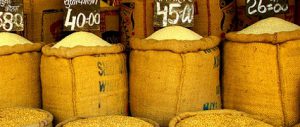The following extract, published with permission, is from the Worldwatch Institute’s State of the World 2011: Innovations That Nourish the Planet. The full report is available from Earthscan (non-US readers) and Worldwatch (US readers).
After more than 50 years of accumulated experience, the global development community still struggles to measure “success” in agricultural development. Policymakers, scholars, activists and farmers each have their own sets of indicators and bodies of evidence. Despite these differences, there have been several important innovations in recent history that have substantially reduced hunger and increased productivity. Learning from these successes can help inform policymaking and leverage investments in ways that contribute to both overcoming hunger and conserving natural resources.
The most dramatic successes over the last 50 years have occurred in Asia. Beginning in the mid-1960s, governments in South Asia introduced policies and accelerated investments in science, infrastructure, inputs and food-price stabilisation, in what became known as the Green Revolution. The result was a doubling of cereal output and yields between 1965 and 1990 as well as improvements in food security for some one billion people between 1970 and 1990.
Beginning in the late 1970s, policy and technological innovations in China similarly accelerated growth and development. Between 1978 and 1984, China reintroduced household farming after more than 30 years of collective agriculture, providing farmers with the incentive to market their surplus. By returning more than 95% of China’s farmland to some 160 million households, the reforms helped increase rural incomes by 137%, reduce rural poverty by 22% and increase grain production by 34%.
But agricultural development is not just about boosting yields and output; it’s about innovation on how we produce, distribute and consume food. Modern dependence on chemical inputs, combined with overuse of soil and water resources, has encouraged innovation in more sustainable farming techniques. In some of the same villages where the Green Revolution first took hold, farmers are now cultivating wheat using zero-tillage techniques that help return nutrients and moisture to the soil.
An estimated 620,000 small-scale wheat farmers have adopted some form of zero tillage since the mid-1980s, accounting for about 1.8 million hectares of land in South Asia and generating average income gains of US$180 to $340 per household, particularly in the Indian states of Haryana and Punjab.
Agricultural development is also about collective action. At the local level, this means vesting communities with a stake in the ownership of a development process, tapping local knowledge and involving communities in project consultations, policy deliberations and scientific research.
In Burkina Faso, innovations in resource management have helped resource-poor households expand the cultivation of food staples such as sorghum and millet. In the wake of repeated droughts, some farmers began innovating based on traditional practices: managing indigenous trees and crops, collecting manure and rainwater in planting pits, and constructing stone contour bunds to control runoff and erosion.
Support from community leaders and nongovernmental organisations contributed to the rehabilitation of 200,000 to 300,000 hectares in the Central Plateau, which translates into roughly 80,000 tonnes of additional food per year — enough to sustain a half-million people. In southern Niger, similar efforts are estimated to have transformed approximately five million hectares of land, improving food security for at least 2.5 million people.
At the global level, collective action means pursuing agricultural development through cooperation and partnerships. In Asia and Africa, concerted efforts to control the spread of rinderpest — a livestock disease capable of killing 95% or more of the animals it infects — through cattle vaccination, quarantine measures and disease surveillance have played an important role in securing the livelihoods of small-scale farmers and pastoralists, preventing substantial financial losses in terms of milk, meat, animal traction and livelihood assets.
What sets these — and many other — developments apart is that they are all relatively large-scale, long-term successes backed by rigorous and well-documented evidence of positive impact and sustainability. More important, these proven successes have demonstrated that agriculture can be a key driver of growth and development. Still, the changing realities of the global food and agriculture system and the persistence of hunger indicate that more successes are needed.
Agriculture is increasingly driven by market demand, consumer preferences and regulatory scrutiny. Emerging information, communications and biotechnologies are providing new opportunities for farmers and consumers, while climate change is imposing new constraints. New demographic concerns are emerging with the continuing HIV/AIDS pandemic, changing age structures and growing urbanisation and migration.
Given these changing realities, a few lessons are worth keeping in mind. First, success is not a substitute for strategy. Sustained success-building is feasible only if countries pursue good strategies, create supporting policies and encourage appropriate levels of investment and experimentation. Decision-makers should design and implement strategies that take a comprehensive approach to raising agricultural productivity, increasing incomes and reducing poverty. This can encourage many intertwined successes to add up to a larger national or regional success story.
Second, success is a process. Agricultural development must address ever-changing priorities and challenges: containing the transboundary movement of diseases and pests, strengthening ecosystem resilience in the face of climate change, improving global trade governance, encouraging investment in developing-country agriculture and articulating grassroots voices more effectively. As such, successes are generated and sustained through experiential processes. This means discovering by doing, learning from mistakes and adapting to change.
Third, success is recognisable. For successes in agricultural development to be recognised, they need to be sufficiently supported by strong evidence, ranging from first-hand accounts to large-scale impact studies. Regardless of the type and level of evidence, the key point is that successes in agricultural development — and failures too — need to be systematically documented, examined and shared so that others can learn lessons, adapt them to different contexts and avoid similar pitfalls.
Finally, success can be ambiguous. Many successes are characterised by a mix of pros and cons. Increases in food production may depend on the use of harmful chemicals, and productivity gains may generate price collapses that hurt farmers but benefit consumers. But ambiguity should not be an excuse for reducing investment in agricultural development. Rather, it suggests the need for careful consideration of difficult trade-offs.
The benefits of interventions that increase the availability, access and quality of food must be weighed against costs in terms of economic and financial gains, environmental impacts and sociopolitical importance.
David J Spielman is a senior research fellow at the International Food Policy Research Institute. Rajul Pandya-Lorch heads the Washington-based organisation’s 2020 Vision for Food, Agriculture and the Environment Initiative.
This extract, published with permission, is from the Worldwatch Institute’s State of the World 2011: Innovations That Nourish the Planet. The full report is available from Earthscan (non-US readers) and Worldwatch (US readers). State of the World 2011: Innovations That Nourish the Planet © Copyright 2011, Worldwatch Institute
Homepage image from Jimmie


